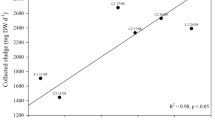Abstract
In this study we assessed the amount of lead accumulated in the body of a grazing mollusc by transfer from its algal food in laboratory experiments, and compared these results with the amounts found in naturally occurring molluscs and seaweed. Near La Jolla, California (USA), where the concentration of lead in seawater is probably less than 0.08 μg l-1, most of the naturally occurring Egregia laevigata contains less than 0.4 μg Pb g-1 wet weight. The total body masses, without shells, of juvenile Haliotis rufescens fed on this seaweed for 3 to 6 months showed similar concentrations. When, however, E. laevigata is placed for 1 to 6 days in seawater to which lead has been added (0.1 or 1.0 mg l-1) both the seaweed and the abalone subsequently fed with it accumulate proportionally larger amounts of lead. After 6 months, young abalone fed on E. laevigata pretreated with 1.0 mg Pb l-1 accumulated up to 21 μg Pb g-1 wet weight. This amount of lead had no apparent consequences on the growth or activity of the molluscs. Analyses of 6 different organs from adult abalone showed that the lead was selectively concentrated in the digestive gland. In the foot (muscle tissue), which is the part normally consumed by humans, only negligible amounts were found.
Similar content being viewed by others
Literature Cited
Bellamy, D.J., D.M. John, D.J. Jones, A. Starkie and A. Whittick: The place of ecological monitoring in the study of pollution of the marine environment. In: Marine pollution and sea life, pp 421–425. Ed. by M. Ruivo. London: Fishing News (Books) 1972. (By arrangement with FAO)
Black, W.A.P. and R.L. Mitchell: Trace elements in the common brown algae and sea water. J. mar. biol. Ass. U.K. 30, 575–584 (1952)
Boyden, C.R.: Trace element content and body size in molluscs. Nature, Lond. 251, 311–314 (1974)
Brooks, R.R. and M.G. Rumsby: Biogeochemistry of trace element uptake by some New Zealand bivalves. Limnol. Oceanogr. 10, 521–527 (1965)
Bryan, G.W. and L.G. Hummerstone: Brown seaweed as an indicator of heavy metals in estuaries in south-west England. J. mar. biol. Ass. U.K. 53, 705–720 (1973)
Calabrese, A., R.S. Collier, D.A. Nelson and J.R. MacInnes: The toxicity of heavy metals to embryos of the American oyster Crassostrea virginica. Mar. Biol. 18, 162–166 (1973)
Hoover, W.L.: Collaborative study of a method for determining lead in plant and animal products. J. Ass. off. analyt. Chem. 55, 737–740 (1972)
Ishibashi, M., T. Fujinaga, R. Morii, Y. Kanchiku and F. Kamiyama: Chemical studies on the ocean (Part 94). Chemical studies on the seaweeds (19). Determinations of zinc, copper, lead, cadmium, and nickel in seaweeds using dithizone extraction and polarographic method. Rec. oceanogr. Wks Japan 7, 33–36 (1964)
Leighton, D.L.: Studies of food preferences in algivorous invertebrates of southern California kelp beds. Pacif. Sci. 20, 104–113 (1966)
Leighton, D.L. A comparative study of food selection and nutrition in the abalone, Haliotis rufescens Swainson, and the sea urchin, Strongylocentrotus purpuratus (Stimpson), Dissertation, University of California, Scripps Institution of Oceanography 1968
Oliphant, M.S. and Marine Fisheries Statistics Staff: California marine fish landings for 1971. Fish Bull. Calif. 159, 1–49 (1973)
Patterson, C.: Lead in sea water. Science, N.Y. 183, 553–554 (1974)
Pinkas, L.: California marine fish landings for 1972. Fish Bull. Calif. 161, 1–53 (1974)
Preston, A.: Heavy metals in British waters. Nature, Lond. 242, 95–97 (1973)
Pringle, B.H., D.E. Hissong, E.L. Katz and S.T. Mulawka: Trace metal accumulation by estuarine mollusks. J. sanit. Engng Div. Am. Soc. civ. Engrs 94 (SA3), 455–475 (1968)
Schulz-Baldes, M.: Die Miesmuschel Mytilus edulis als Indikator für die Bleikonzentration im Weserästuar und in der Deutschen Bucht. Mar. Biol. 21, 98–102 (1973)
— Lead uptake from sea water and food, and lead loss in the common mussel Mytilus edulis. Mar. Biol. 25, 177–193 (1974)
Young, E.G. and W.M. Langille: The occurrence of inorganic elements in marine algae of the Atlantic provinces of Canada. Can. J. Bot. 36, 301–310 (1958)
Author information
Authors and Affiliations
Additional information
Communicated by M.R. Tripp, Newark
Rights and permissions
About this article
Cite this article
Stewart, J., Schulz-Baldes, M. Long-term lead accumulation in abalone (Haliotis spp.) fed on lead-treated brown algae (Egregia laevigata). Marine Biology 36, 19–24 (1976). https://doi.org/10.1007/BF00388424
Accepted:
Issue Date:
DOI: https://doi.org/10.1007/BF00388424




